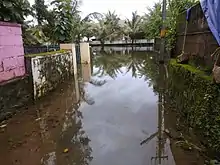2019 Kerala floods
On 8 August 2019, due to heavy rainfall in the monsoon season, severe flood affected Kerala.[2] As a security measure in the prevailing situation of heavy rains, the India Meteorological Department had issued a red alert in the 9 districts in Northern and Central Kerala, orange alert in 3 districts of Central Kerala, and yellow alert in the 2 districts of southern Kerala.[3] Thousands of people have been evacuated to safer places and relief camps.[1][4] A total of 121[1] people have died due to rain-related incidents as of 19 August 2019.
 | |
| Date | 8 August 2019 – 29 August 2019 |
|---|---|
| Location | Kerala, India |
| Cause | Heavy rain Discharges Landslide |
| Deaths | 121 dead [1] |
| Property damage | To be estimated |
| Website | www |

Another deluge had hit the state in August 2018, in which over 470 people died and properties worth US$5.8 billion (₹40000 crore) were damaged.
Causes
The extreme rains were triggered by a depression that formed in the north-west Bay of Bengal near the Odisha coast. This depression strengthened monsoon currents across the Arabian sea resulting in intense convection over Kerala.[5] Every year parts of South Asia are hit by a period of heavy rains known monsoons which usually fall between June and September. It is caused by a change of wind patterns over the region. This change causes heavy rains in the summer and long dry spells over the other months. In India, the monsoon rains can provide 70% of the country's rainfall for the year. The rain fall so quickly and heavily that it can cause sudden flooding.
Unrestricted mining operations in places have contributed to environmental degradation. Scientists who have conducted research on the disaster-prone areas have warned that soil-piping is a major cause for the landslides witnessed in these places and the high ranges of Kerala will likely be worst hit if this continues. Also known as 'tunnel erosion', soil piping is the subsurface erosion of soil caused by percolating waters to produce pipe-like conduits below the ground, especially in non-lithified earth materials.[6]
Impact
As of 19 August 2019, 121 people have been killed due to the floods across the state of Kerala.[1] Over 2 lakh people have been directly affected by the flood, and have been shifted to 1318 relief camps in different parts of Kerala.[1] Airport authorities suspended operations of the flood-affected Cochin International Airport till 15:00 (IST) on 11 August 2019. The data from the Kerala State Disaster Management states that, as many as 1,789 houses had been damaged fully in between 8 and 19 August, while the number of partially damaged houses is 14,542.[7]
There have been 80 landslides in the span of 2 days, as said by the Chief Minister. Many people who are feared to be buried alive under them are being rescued. It is still a critical situation as the calamities interfere with the rescue operations. Districts that have been severely affected include Wayanad, Malappuram, Kozhikode, Kannur, Palakkad, Thrissur and Ernakulam districts.
Rescue
Kerala's State Disaster Management Authority, Kerala police along with the Indian Air Force, civilians, volunteers, White Guard Volunteers [8] fishermen from coastal Kerala are actively taking part in the rescue operations in flood-affected regions.[9] However, inclement weather with heavy rains and landslides are hampering the rescue operations in the hilly regions of Wayanad, Malappuram, and Kozhikode districts.[9] 83 National Disaster Response Force(NDRF) teams were deployed in addition to the 173 teams of Army, Navy, Air Force, and Coast Guard to take part in the relief operations.[10]
Animal rescue was carried out by local NGOs and activists on ground mainly in places like Wayanad and Nilambur. Notable work was done by Sally Varma of Humane Society International/India in Nilambur where around 500 kg of dog food and more than 5000 kg of cattle feed and 2500 kg of goat feed was distributed to the starving animals.[11]
Relief and Monetary Aid
Immediate financial aid of up to Rs 10,000 each for all calamity-hit families which had suffered losses in the torrential rains. A sum of Rs 4 lakh would be given to those whose houses had been fully damaged or had become uninhabitable and Rs 10 lakh to those who had lost their houses as well as land in the rain fury and landslides, Chief Minister's cabinet meeting.Kerala Govt Announces Flood relief Package; Rs 10,000 Immediate Aid to Calamity-hit Families
In August 2019, Public has been very generous contributing to Chief Minister's Distress Relief Fund. As on 15 Aug 2019 at 1940 hrs income is 4368.2 Cr (INR).
References
- "Death toll in flood-hit Kerala rises to 121, 40 injured". India Today. Ist. Retrieved 22 August 2019.
- "Kerala flood: Heavy rains, landslides wreak havoc in state; red alert issued in 4 districts". Business Today. 8 August 2019. Retrieved 8 August 2018.
- https://twitter.com/vijayanpinarayi/status/1159719778082181120?s=20
- "Kerala sees heavy rains: many areas flooded, hundreds shifted to relief camps". The News Minute. 8 August 2019. Retrieved 8 August 2018.
- "End of season Monsoon report". IMD. 5 July 2020. Retrieved 5 July 2020.
- Jacob, Jeemon (5 September 2019). "Kerala's man-made disaster". India Today.
- "Kerala Floods 2019: 121 dead, 1,789 Houses Collapsed". NewsClick. 20 August 2019. Retrieved 21 August 2019.
- "Youth League workers clean up Sreerama temple in Wayanad".
- "Kerala rains live updates: Toll climbs to 22; Army, IAF help sought". 9 August 2019 – via www.thehindu.com.
- "83 NDRF teams dispatched for flood relief, rescue in four states, says MHA". The New Indian Express.
- "Kerala floods: When dogs turned guardian angels".
External links
| Wikimedia Commons has media related to 2019 Kerala floods. |